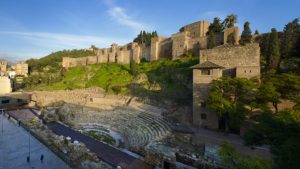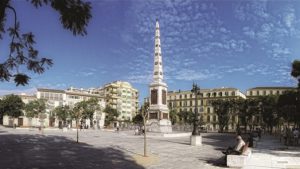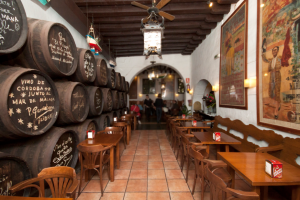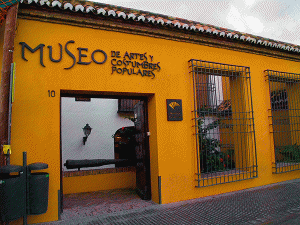Discover Malaga
Many people have visited the great city of Malaga for its climate, its welcoming people, its streets or its fair. However, many people have not yet visited or aren’t even aware of what the city has to offer.

At CBLingua we invite you to visit Malaga and to get you in the mood, we’re going to take you on a tour of the main places of interest of the city.
Places of interest

La Alcazaba
La Malagueta. When you think of Malaga the first thing that comes to mind is its beaches. Highlights include taking a walk or a dip, eating the famous fish-on-a-stick barbecue espetos or relaxing on the Malagueta beach, the most popular in the city of Malaga owing to its central location making it easy to get to. Sunrise on this beach is a unique Malaga memory.
The Alcazaba. No visit to Malaga would be compete without a visit to this Arabic palace-fortress. There are few places where a visitor can experience the fusion of such history and beauty in the same place. Built in the Taifa period, in the 11th Century to be exact, it was constructed on the site of an older fortress of Punic-Phoenician origin. Its unique location, found on the hillside of Mount Gibralfaro, allows you to appreciate its grandeur from almost any part of the city.
The Castle of Gibralfaro. Just up from the Alcazaba, on the same mountain, the Castle of Gibralfaro is found. In the 10th century, Abd-ar-Rahman III decided to convert ancient Phoenician ruins into a new fortress. For history lovers, the castle is home to an interpretation centre where you can learn about military history with the soldiers of the time's basic military dress. When summer arrives along with its good weather, cultural shows of all kinds play out in the interior of the castle; flamenco, jazz, classical and ethnic dance just some of the examples you can experience during this compulsory visit. The port city of Malaga’s crowning glory leaves everyone enthralled. The castle is an emblematic symbol of Malaga represented in the coat of arms of the city, the province and even in the logo of Malaga Football Club.
Malaga Cathedral. The Manquita, the name by which the malagueños fondly refer to this asymmetric temple, seems to have just one tower on its left side looking at its façade. It is considered one of the best buildings of the Renaissance style that exists on Andalusian soil. This cathedral, boasting enormous and beautiful works of art on all four sides is a must-see. While the exterior is astonishing, the interior is captivating. Its chancel is a masterpiece of carpentry and its gothic altarpieces have a delicate beauty, much like its stained-glass windows. You can see all of this inside an enormous area in which you will lose the notion of space.

Plaza de la Merced
Plaza de La Merced. As you’re passing through the streets of Malaga and you end up in this square, it’s a spectacular sight. A wide square in the middle of the city, with an obelisk dedicated to General Torrijos located right in the middle. This renowned square plays host to shows and expositions throughout the year. The Plaza de la Merced has been home to the famous painter Pablo Picasso and General Riego.
Cuisine
Malagueño cuisine stands out for its distinct Mediterranean flavour. Of course fish is its signature dish, and you can try it in all the bars and restaurants in the city and in all its forms, such as the famous espetos, mussels in pipirrana or cazón en amarillo (school shark). Its pastry-making also stands out, influenced greatly by Arabic culture. Its stellar ingredients include dry fruits, nuts and honey. Below we will show you some of the bars and restaurants to visit in Malaga.

Pimpi
El Pimpi. Well-known restaurant and winery in Malaga. Its wines originating from Malaga are its speciality. There’s nothing like savouring some cod fritters cooked with the utmost care, accompanied with a glass of Malaga wine, surrounded by wine casks signed by great Flamenco artists like Rocío Jurado. This restaurant is also known for having been an academy for the great malagueño Flamenco artists.
Restaurante Miguel. Here you can try various meats like ox sirloin or dishes like cod preserve or rice with lobster. Its location in a small establishment and its excellent service will make you feel as if in you were in your own home.
Cafetería del Jardín Botánico. Great spot located in a key location for taking a walk, clearing your head and having a coffee in the shade of the trees. You can try one of their speciality salads, their delicious goat’s cheese salad.
Culture
Picasso Museum. One of the first things that comes to everyone’s mind when we think of malagueño culture is the painter Pablo Picasso. You can’t leave Malaga without visiting this museum, opened in 2003 and home to iconic works such as “Fruit Bowl”, “Olga Khokhlova with Mantilla” and “Woman with Raised Arms”. Inside you can also see seasonal expositions.

Museum of Arts and Traditions
Museum of Arts and Traditions. If you love history but also want to be a part of it, you can travel back in time and visit this museum where you can see the traditions of the 18th and 19th centuries exactly as they were in Malaga. Inside you can see the recreation of the main economic activity of the time including fishing, oil production and winegrowing. In this journey in time you’ll also see traditional dress of the period, examples of pottery and other decorative motifs.
Fundación Picasso-Museo Casa Natal (Birthplace Museum). If you’re interested in art and the Picasso Museum left you wanting more, in the Plaza de la Merced, in the house of Pablo Picasso’s birth to be exact, you can find this museum housing more of Picasso’s work, sketches of his work “The Young Ladies of Avignon” and works by other Malaga-related artists like Miró.
The Wine Museum. The wines of Malaga are world-renowned. The winegrowers of the region wanted to promote the opening of this museum to further promote Malaga wines at a national and global level. The museum was also founded with an educational purpose for the visitors of today to discover the history of wine. Here you can learn about this traditional drink’s history through the records as well as the wine cellars.
Leisure
The great weather and the friendly mature of the malagueño people is what makes the parties in Malaga so special. Its Holy Week, with World Heritage status, stands out with the Virgen de la Salud parade. Another famous event, hotly anticipated by the Malaga residents, is its fair, with an explosion of charm in the middle of the city during the day.
Shopping. For shopaholics, a recommended visit is Calle Larios, the main high street for shopping along with other important shopping streets like Carretería, Álamos and Alcazabilla.
Theatres. The Cervantes Theatre must be highlighted first and foremost, for its 1,200 seater capacity and its age. The Cánovas Theatre in El Ejido Square, in which you can enjoy rock concerts, flamenco shows and even puppet shows for the younger visitors. Other notable theatres include the Alameda and the Echegaray.
Cinemas. For film buffs, Malaga and the Costa del Sol boast grand state-of-the-art screening rooms, such as the Centro Comercial Plaza Mayor and the Centro Comercial de La Rosaleda.
Sport. Malaga is a city with sufficient sporting facilities to host national and global tournaments and events. Some examples include the Jose Maria Martin Carpena Arena, where the European Water Polo Championships were hosted, and La Rosaleda Stadium, the home of Malaga Football Club where first division games and sometimes even Champions League games are played.
